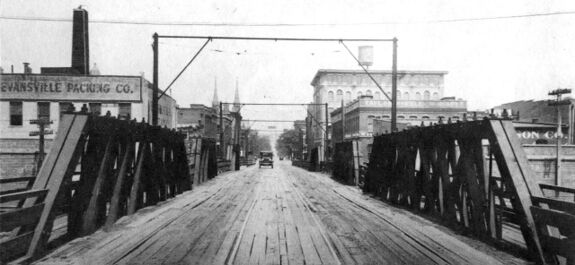22nd Street viaduct
The 22nd Street viaduct is a road bridge connecting 22nd Street South to 22nd Street North over the Railroad Reservation, Morris Avenue to the north and Powell Avenue to the south.
The original span was approved in 1884 as the first bridge to cross into Southside over the railroad tracks. The Elyton Land Company agreed to build it at no cost to the city in exchange for the privilege of running its streetcars over it. Their engineer T. A. E. Evans designed the 1,000-foot long bridge which had a 21-foot-wide center vehicle lane flanked by two 5-foot pedestrian ways, decked with 2" thick heavy wood planks. It was erected by Tom Devereaux between August and October 1885, using 2000 cubic yards of stone, 200,000 board feet of lumber, 16 tons of steel and 5 tons of iron. Meda Brooks was given the honor of making the first crossing.
1929 bridge
That bridge was replaced in the late 1920s when the railroad tracks were elevated in the downtown area to eliminate grade crossings. Funds for a new viaduct were included in the 1928 Birmingham bond referendum, though no agreement had been completed with the Birmingham Electric Company to contribute to its construction.
The design called for a 1,000 foot long by 70 foot wide deck, reaching 22 feet above the tracks. A $180,000 construction contract was awarded to Millsap & Parker on January 1, 1929 and the new bridge opened on September 4 of that year. 9-year-old Ann Argo, Meda Brooks' granddaughter, made the first crossing, leading Commission President James Jones, Commissioner W. E. Dickson, city engineer A. J. Hawkins, and Edward Wise Jr.
The northeast edge of the viaduct is built directly adjacent to a building on the south side of Morris Avenue. The portion of the building's wall projecting above the span was used as the site for "Geo-Chromatic Progress", one of Michael Mojher's paintings completed under the auspices of the Birmingham Urban Mural Project in 1978.
During that same year, the city, at the behest of Morris Avenue project coordinator Richard Mansfield-Jones Jr, made plans to construct a "piazza" beneath the viaduct for $45,000.
The span gained a degree of local press in the summer of 2000 when the city used duct tape to temporarily fix crumbling balusters while waiting for appropriations from the Alabama Department of Transportation for more permanent repairs.
Gallery
References
- "City to Vote on $4,000,000 Bonds to Raise Tracks" (February 21, 1928) The Birmingham News, p. 1
- Dalrymple, Dolly (August 20, 1929) "Little Girl to Follow Grandmother's Steps In Opening Of New Viaduct Here." The Birmingham News, p. 1
- "Birmingham's first 'viaduct' erected 65 years ago" (August 31, 1950) The Birmingham News, p. 20
- Nesbitt, Jim (July 29, 1978) "Morris Avenue–will it make it?" Birmingham Post-Herald, p. C1
- MacDonald, Ginny (July 7, 2000) "Duct tape bridges the gap." The Birmingham News

